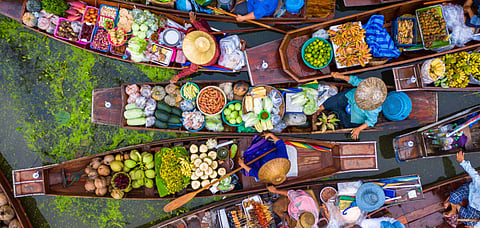
- Destinations
- Experiences
- Stay
- What's new
- Celebrating People
- Responsible Tourism
- CampaignsCampaigns
- SubscribeSubscribe
- Buy Now

While all of us have been to the picturesque shores of Thailand, there are plenty of offbeat destinations to explore in this island nation. From hidden islands to unique geological formations with intriguing stories, these lesser-known places unveil a side of Thailand off the beaten path. Venture into the heart of the country, and you may stumble upon ancient ruins shrouded in mystery and folklore. Quirky and unconventional temples showcase peculiar collections, ranging from oddities and curiosities to unique art installations that challenge traditional norms. Here are a few unique sites you must include on your itinerary on your next trip to Thailand.
David Beckham Temple, Wat Pariwar
This Buddhist Temple in Bangkok is known for its collection of quirky sculptures depicting famous personalities and beloved superhero characters. Among these sculptures, the football legend David Beckham's statue stands out, attracting visitors worldwide. Crafted by Thai sculptor and senior monk Thongruang Haemhod two decades ago, the Beckham statue holds significance as it coincided with Manchester United's historic achievement of winning the treble of trophies, marking them as the first English football club to do so.
The gold-painted Beckham statue can be found on the temple's altar, capturing the essence of the renowned player. Alongside the soccer icon, prominent figures like Albert Einstein and Che Guevara and beloved superhero characters like Captain America and Batman have been intricately carved, further adding to the temple's whimsical architecture.
Death Railway, Kanchanaburi
The Death Railway, located in Kanchanaburi, carries a harrowing history associated with its construction during World War II. Built by prisoners of war and Asian labourers, the railway bears witness to the immense suffering and sacrifice endured during that time.
Under the Japanese Army occupation, numerous skilled and healthy prisoners of war, alongside Asian labourers, were conscripted to work on various projects, including the railway line. It is said that between 1942 and 1943, the construction claimed the lives of tens of thousands of labourers, resulting in a tragic loss of life, therefore getting it the infamous moniker, the "Death Railway." The hardships faced by the labourers, coupled with harsh conditions and inadequate resources, contributed to the staggering number of fatalities.
White Temple, Wat Rong Khun
Renowned as the White Temple, Wat Rong Khun is a masterpiece mesmerising tourists for its shimmery appearance. Every inch of the temple, from its gleaming white exterior to its intricate designs, showcases unparalleled craftsmanship. The visionary behind this unique temple is Chalermchai Kositpipat, a celebrated Thai visual artist. Temple's carefully designed architecture makes it dazzle under the sunlight. Tiny glass fragments are meticulously placed within the white plaster used during construction. Despite enduring significant damage during the 2014 earthquake, the temple stands strong even today, with its appearance continuing to awe visitors.
Grand Canyon of Thailand, Sam Phan Bok
Sam Phan Bok is a unique and lesser-known destination in Thailand, accessible only during specific months of the year. Located in the middle of the Khong River, it has earned the moniker of the "Grand Canyon of Thailand." This small island becomes submerged under water during the flood season, making it a temporary attraction. The distinct geological feature of Sam Phan Bok is the result of circular water currents that have gradually eroded its surface, creating over 3,000 small basins. It is from this distinctive characteristic that the place derives its name, "Sam Phan," which translates to "three thousand," while "Bok" in Lao signifies "small basins." This offbeat destination offers a glimpse into the wonders of nature and the ever-changing dynamics of water and land.
Buddhist Hell Temple, Wat Mae Kaet Noi
While Buddhist temples are often associated with inner peace, one particular place of worship in Thailand offers a unique and chilling experience. Located in Chiang Mai, Wat Mae Kaet Noi, commonly known as the Hell Temple, diverges from the traditional serene atmosphere by vividly depicting the underworld and its associated suffering. The Hell Temple was established to illustrate the consequences of one's actions and the repercussions of sin. The monk who designed it wanted to provide believers with a visual depiction of the torments awaiting those who transgress moral boundaries. Interestingly, the temple's popularity has made it a venue for various events, including birthdays, weddings, and funerals. Visitors can encounter a striking collection of life-sized and oversized statues within the temple grounds, vividly portraying gruesome acts and punishments associated with hell.
Cover photo credit Shutterstock
ALSO READ Priceless Promises Of Thailand
